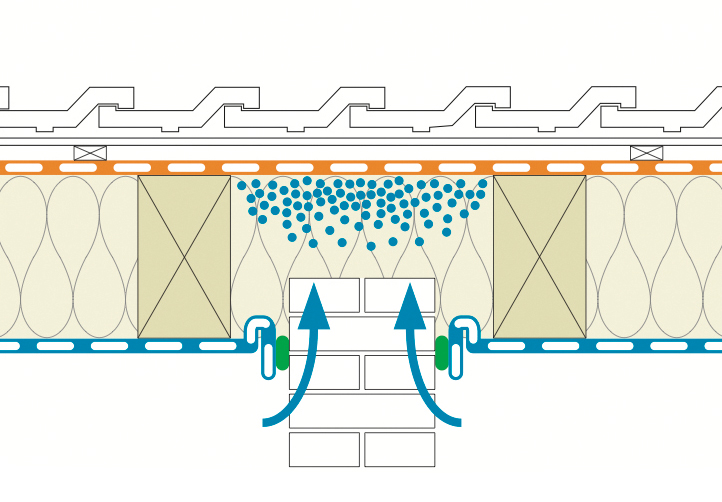pro clima clients ask – pro clima engineers answer
Airtightness is good, but it is not everything: there is also the matter of diffusion! When we speak of diffusion in civil engineering, we are referring to the gradual transport of moisture through a building component. This transport is driven by the pressure difference between the interior and exterior. As water molecules always want to move from warm environments into the cold, diffusion normally occurs from the inside to the outside in wintertime. A vapour retarder hinders the transport of these molecules.

For example, if an interior wall penetrates through an insulation layer (the vapour retarder is cleanly attached to the wall on the left and right, i.e. everything is airtight), so-called flank diffusion can occur. The water vapour looks for the path of least resistance – which in this case is the interior wall. In the case of structures that are open to diffusion on the outside, this may represent a manageable risk. However, if the structure is impermeable to diffusion on the outside, moisture problems can soon occur. After all, there is a fundamental problem here. The interior wall has a large surface area, so it absorbs a lot of moisture, but there is only a smaller area available for drying to the inside – i.e. the wall cap.
If a humidity-variable vapour retarder such as INTELLO is used, the area available for moisture to diffuse out of the building component again is increased. An additional advantage is that the humidity-variable vapour retarder shortens the path for drying to the inside. It reduces its sd value and moisture can quickly escape from the building component. If vapour retarders are used that allow for no or too little drying to the inside, the risk of a build-up of moisture increases in the area around the bound interior wall, and the structure becomes damp as a result. Damage to the structure becomes inevitable.
Additional information:
pro clima technical team
 Christoph Böhringer of pro clima Germany answered this question. The engineers in Timber Construction can help you quickly and effectively in an expert manner and can offer solutions on cost-effective, reliable constructions that lead to healthy living environments.
Christoph Böhringer of pro clima Germany answered this question. The engineers in Timber Construction can help you quickly and effectively in an expert manner and can offer solutions on cost-effective, reliable constructions that lead to healthy living environments.
pro clima technical support is available to you all over the world. Find your local technical support team here:
http://www.proclima.com/service/technical-support
Have an interesting technical question you would like answered? Contact us at: presse@proclima.de
Robert haverlock says:
Please explain that further, give examples of typical US built hoses, and what needs to change?
Also, explain that photo above and give insights of how that is built and it’s componates?
Thank you